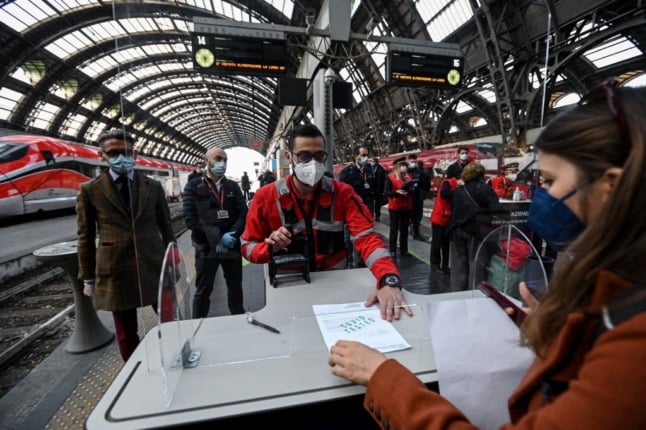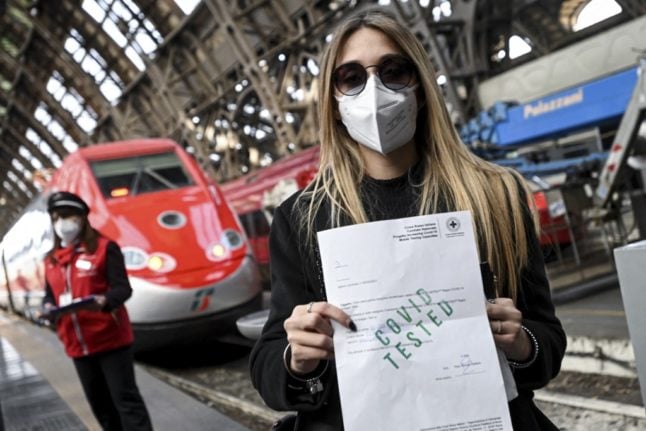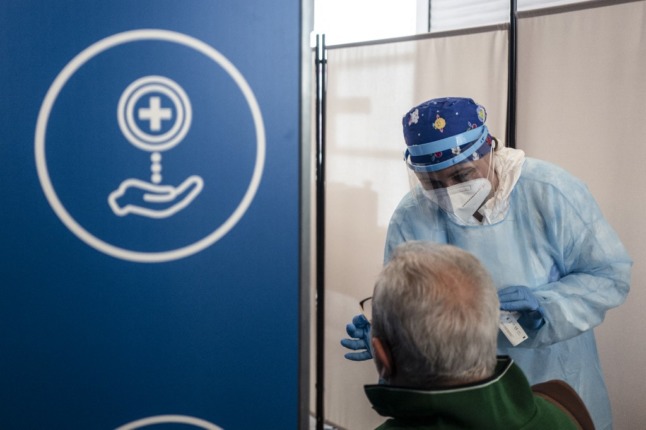Question: We’re planning to fly to Italy from the UK and back. What are the rules, and is a negative lateral flow test result valid for entry into the country?
Testing requirements are in place for arrivals to both Italy and the UK at the moment – though isolation rules have been eased by both countries for travellers who are fully vaccinated.
Many people planning a trip have have written to The Local to ask what kind of test they need to take for entry, how to get tested in Italy for the return journey, and whether the rules vary if they’re just coming to Italy for a short stay.
Q&A: Answers to your questions about Italy’s new travel rules
According to the Italian Ministry of Health, it is compulsory that you “produce a green certificate proving that you have taken a negative molecular or antigen swab test in the 48 hours prior to entering Italy”.
For now, the rapid ‘lateral flow’ home tests do not appear to be accepted by Italian authorities. You’ll need to get the required document from the clinic or other testing centre.
The mentioned ‘green certificate’ is what Italy is currently calling any document proving a negative test result from a testing centre, and there are no requirements for it to be in any particular language (so English is fine, therefore).

Instead, here are the stated molecular and antigen swab tests explained:
A PCR (molecular) test – referred to in Italian as un tampone (“a swab”), this is the more reliable, but also more time-consuming test, which tells you if you are actively infected with coronavirus. It involves taking a nose or throat swab and examining it for traces of the virus’s genetic material. It’s not a quick turnaround, as the sample has to be sent to a lab for analysis, which means results can take around a day.
It’s considered the most reliable form of testing, even if it’s not 100 percent accurate. If you’ve got symptoms of Covid-19, this is the one you’ll most likely be asked to take, or it may be needed to confirm the results of an antigen or antibody test. These can cost anywhere between £120 – £200 in the UK.
An antigen test (test antigene or test antigenico, or sometimes just tampone rapido, “fast swab”) is quicker and you can get results in around 15-20 minutes and is the test being used for the screening of passengers at airports, stations and ferry terminals in Italy. It’s conducted via a nasal swab and the sample is tested for proteins that are found on the surface of the virus. It’s less accurate than the PCR but it’s cheaper and faster as there’s no need for a lab. This one comes in at around £80 in the UK.
Children aged six and under are exempt from the testing requirement.
As the rules are changing frequently, the Italian government has created this travel calculator to give you the latest travel requirements from your country of origin. So, for coming from the UK, select ‘United Kingdom’ from the dropdown list and follow the steps.

What about going back to the UK?
Italy is on the UK’s amber list, meaning that when you return to the UK, you need to do the following:
- provide a negative Covid test taken within the previous 72 hours. UK rules allow either a PCR test or an antigen test of more than 97 percent specificity and 80 percent sensitivity – the rapid-result antigen tests available at pharmacies or testing centres around Europe meet this specification but most home-testing kits do not. According to official guidelines, this could include PCR tests or an “antigen test, such as a test from a lateral flow device“. However, it’s your responsibility to ensure the test meets the minimum standards for sensitivity. The results must be in English, French or Spanish and can be provided either as a printed document or “an email or text message you can show on your phone”.
- fill in a contact locator form – this form must be filled in before you arrive at the border and you will need the order code from your travel testing kit (see below) – find the form HERE.
- order a travel test package – you need to order this home-test kit in advance and take further Covid tests on day 2 and day 8 of your quarantine. These tests are compulsory (you will need the order code to complete your contact locator form) and cost on average a staggering £200 per person – you can find the list of approved providers HERE.
Travellers who are not fully vaccinated will also have to follow a ten-day isolation requirement:
- “you must quarantine in the place you’re staying and take 2 Covid-19 tests”, according to the UK government website. The quarantine period can be spent at a location of your choosing including the home of family or friends. There is also an option to pay for an extra test on day 5 and, if it is negative, leave quarantine early. These restrictions are because Italy is currently on the amber list. If it moves to the green list, quarantine would be dropped but you would have to take a Covid test on or before day 2 of your quarantine.
What happens if you don’t provide a negative test result?
You may not be able to board your transport back to the UK and if you arrive in England without proof of testing negative you could be fined £500.
You have to follow these rules, even if you’ve been vaccinated. These are the latest rules for England, but find out what to do if you’re
What about coming to Italy for a short stay? Is there time to go through all the testing procedures?
Another question related to travel and the testing requirements is whether it’s possible to come to Italy for a weekend or whether you have to come for a longer stay.
A kind of workaround is available if you plan to come to Italy for a short time.
“If you are returning to the UK within 3 days, you can use the result of a Covid-19 test that you take in the UK before you travel. You must use a private test provider for the test and not an NHS test,” state the UK authorities.
“The service on which you will arrive back in the UK must set off for the UK within 3 days of when you took the test,” they added.
So that means you can get a UK-approved test before departure from the UK, as long as you return to the UK within 3 days, meaning you don’t have to find a testing centre while in Italy.
Where can I get tested?
If however, you are coming to Italy for longer and you need to get tested while here, the quickest and easiest way is to pay for a private test.
These tests can be carried out without a prescription at airports, pharmacies, labs, testing centres, or even at your accommodation via private doctors such as Med in Action or Medelit.
How much you pay varies, but is usually set by the regional health service, with molecular tests usually costing more than rapid antigen swabs. In the Lazio region around Rome, for instance, antigen tests cost around €20 while a molecular test is around €60. House calls or same-day results can cost considerably more.
Where to find test centres near you
Several international airports in Italy, including Rome Fiumicino, Milan Malpensa, Venice, Florence, Pisa, Bari and others, have on-site Covid testing facilities. Tests are usually rapid antigen swabs, though others may be available, and fees range from around €20 (Florence and Pisa) to €50 (Milan).
Many Italian pharmacies also offer rapid antigen testing, often in tents outside the building. Ask your nearest pharmacist for advice.
Facilities need special authorisation to analyse molecular tests: find a list of government-approved labs here. Bear in mind, however, that it only includes places that actually process the sample; other centres or doctors can also take the swab and send it to one of these labs.
There are also nationwide private testing networks with locations in several parts of Italy, including Synlab, Lloyds Farmacia and Affidea.
Where to get test results in English
While the EU has advised that all test results should be issued in both the local language and English, some test centres may charge extra for a certificate in English. Check the terms with the facility before booking an appointment.
Find a list of test centres that provide results in English here. The service is becoming more widely available, so try searching “tampone Covid certificato in inglese” plus the name of your town to find more places that offer it near you.
For more information on the requirements for travel to Italy (in English):
- Italian Foreign Ministry’s information page for Italian citizens returning from abroad and foreign citizens in Italy
- Italian Foreign Ministry’s ‘safe travels’ website www.viaggiaresicuri.it
- Italian Health Ministry’s travel information page.
You can also call the Italian coronavirus information line:
- From Italy: 1500 (toll-free number)
- From abroad: +39 0232008345 , +39 0283905385
See the latest news updates from Italy in The Local’s travel section.



 Please whitelist us to continue reading.
Please whitelist us to continue reading.
Does anyone know where you can obtain a covid test result in english in the Terni area of Umbria please?